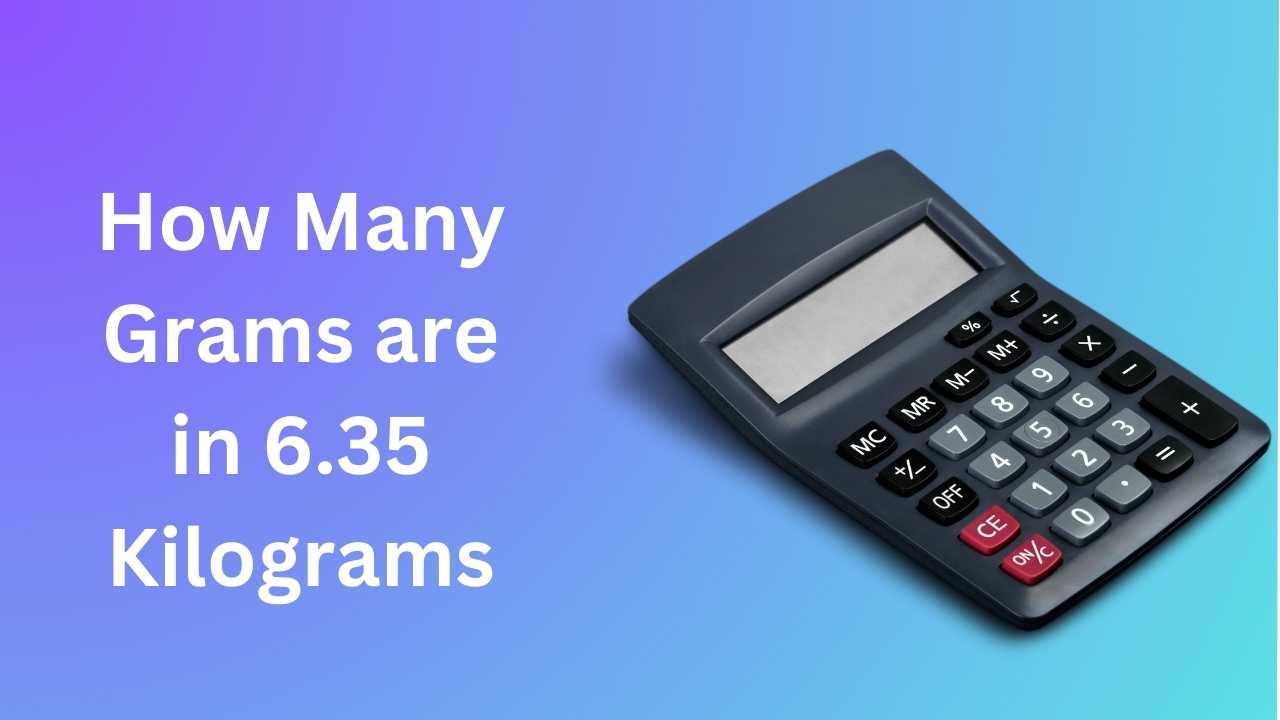In the realm of measurement systems, the metric system stands out as a globally recognized and widely adopted system. Its uniformity and ease of use make it a valuable tool for scientists, engineers, and everyday people alike. One of the fundamental aspects of the metric system is its decimal-based nature, which allows for simple conversions between different units of measurement. In this article, we will explore the conversion of 6.35 kilograms to grams, providing a comprehensive understanding of the process.
Read also: Kalyani Priyadarshan Weight Loss Journey 2022
How Many Grams are in 6.35 Kilograms:
Overview of the Metric System:
The metric system, also known as the International System of Units (SI), is a decimal-based system of measurement used worldwide. It offers a consistent and logical framework for expressing quantities across various disciplines, including physics, chemistry, and everyday life.
Read also: Weight Loss: Important Dieting Tips To Lose Weight fast
Units of Mass in the Metric System:
In the metric system, mass is measured in grams (g) and kilograms (kg). The gram is the smaller unit of mass, while the kilogram is the larger unit. The relationship between grams and kilograms is based on powers of ten, with 1 kilogram equaling 1000 grams.
Converting Grams are in 6.35 Kilograms::
To convert kilograms to grams, we need to utilize the relationship that 1 kilogram is equal to 1000 grams. This means that to convert any given value in kilograms to grams, we can simply multiply the number by 1000.
Read also: Instagram Hidden Face Pose: A Guide to Taking the Perfect Shot
Applying the Conversion:
Now, let’s apply this conversion to the specific case of 6.35 kilograms. To convert this value to grams, we multiply 6.35 by 1000.
6.35 kilograms * 1000 = 6350 grams
Therefore, 6.35 kilograms is equivalent to 6350 grams.
Significance and Examples:
Significance of Converting Kilograms to Grams:
Converting kilograms to grams is useful when dealing with measurements that require a finer level of precision or when working with smaller quantities. By converting to grams, we can express the mass in a more detailed and precise manner.
Read also: 7 Killer Tips To Get a Perfect Selfie
Examples of the Use of Kilograms to Grams Conversion:
The conversion from kilograms to grams finds relevance in various real-world scenarios. For instance:
- In a laboratory setting, researchers may need to measure the precise mass of a chemical compound or a sample, requiring the use of grams. This level of accuracy is essential in fields such as pharmaceuticals, where precise measurements are crucial for drug formulations and quality control.
- When weighing ingredients in recipes, some recipes might specify quantities in kilograms, while others may require more precise measurements in grams. This conversion allows for seamless adjustments and accurate ingredient measurements.
- In commercial applications, manufacturers often deal with larger quantities of products measured in kilograms, while packaging or labeling might require the weight to be expressed in grams. This enables clear communication with customers and compliance with regulations.
Practical Tips for Grams in 6.35 Kilograms::
Using Multiplication and Division:
To convert from kilograms to grams, multiply the number of kilograms by 1000. To convert from grams to kilograms, divide the number of grams by 1000. These simple multiplication and division operations allow for quick and accurate conversions.
Read also: Alia Bhatt’s Height, Age, Net Worth and More
Decimal Point Placement:
When converting from kilograms to grams, it is important to pay attention to decimal point placement. The decimal point remains in the same position, but the value is multiplied by 1000. For example, if you have 3.5 kilograms, the conversion to grams would be 3500 grams.
Rounding:
In some cases, it may be necessary to round the converted value to a specific
number of decimal places, depending on the context or level of precision required. Always consider the specific requirements of your task or calculation when determining the appropriate level of rounding.
Conclusion:
Understanding the conversion How Many Grams are in 6.35 Kilograms: is essential for anyone working with the metric system. By knowing that 1 kilogram is equal to 1000 grams, we can easily convert values from one unit to another. In the case of 6.35 kilograms, the conversion yields 6350 grams. This knowledge allows us to express mass with increased precision and flexibility, enabling us to perform a wide range of scientific, industrial, and everyday tasks accurately.
Read also: Weight Loss tips: वजन कम करें बिना किसी डाइटिंग और जिम के
Remember, the metric system’s simplicity and consistency make it a powerful tool for measurement, fostering clarity and facilitating global communication across various fields of study. By mastering the conversion between kilograms and grams, you can navigate the metric system with confidence and efficiency.
Frequently Asked Questions (FAQs):
1. Why do we use the metric system for mass measurement?
The metric system offers several advantages, including its decimal-based nature, ease of conversion between units, and widespread international adoption. Its uniformity allows for clear communication and simplifies calculations in scientific, industrial, and everyday applications.
2. Can I convert kilograms to grams using a different factor?
No, in the metric system, the conversion factor between kilograms and grams is fixed at 1 kilogram equals 1000 grams. This relationship is based on the decimal system, where each unit is a multiple of 10 or its power.
3. How can I convert grams to kilograms?
To convert grams to kilograms, divide the number of grams by 1000. For example, if you have 5000 grams, dividing by 1000 gives you 5 kilograms.
4. Are kilograms and grams used interchangeably?
Kilograms and grams are different units within the metric system. Kilograms are typically used to measure larger quantities of mass, while grams are used for smaller or more precise measurements. However, they are easily convertible, and depending on the context, the appropriate unit can be used.
5. Are kilograms and grams used in everyday life?
Yes, kilograms and grams are commonly used units of measurement in everyday life. They are often used for measuring ingredients in cooking, calculating body weight, determining package weights for shipping, and more.
6. Are there any other units of mass in the metric system?
While grams and kilograms are the primary units for mass in the metric system, there are also larger units such as metric tons (equal to 1000 kilograms) and smaller units such as milligrams (equal to 0.001 grams).
7. How accurate is the conversion between kilograms and grams?
The conversion between kilograms and grams is an exact conversion because it is based on the decimal system. Therefore, the conversion is accurate and precise.
8. Can I convert kilograms to grams using a calculator or an online tool?
Yes, calculators and online conversion tools can be used to convert kilograms to grams. Simply input the value in kilograms, and the tool will provide the converted value in grams.
9. Are there any historical reasons behind the adoption of the metric system?
The metric system was developed during the late 18th century as a result of the French Revolution’s drive for uniformity and standardization. Over time, its logical and consistent nature gained widespread international acceptance, leading to its adoption in many countries.
10. Is the metric system used globally?
Yes, the metric system is widely used and accepted across the globe, with only a few exceptions. The majority of countries have officially adopted the metric system as their primary system of measurement.



